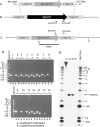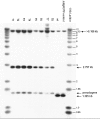New capabilities for Mycosphaerella graminicola research
- PMID: 20696006
- PMCID: PMC6640411
- DOI: 10.1111/j.1364-3703.2010.00629.x
New capabilities for Mycosphaerella graminicola research
Abstract
Mycosphaerella graminicola is a major pathogen of wheat worldwide, causing Septoria leaf blotch disease. Targeted gene disruption in M. graminicola, by Agrobacterium tumefaciens-mediated transformation, has become an established functional genomics tool for M. graminicola research in recent years. However, in order to advance research into this economically important pathogen, further functional genomics tools need to be developed. Here, we report three new capabilities for M. graminicola research: (i) two selectable markers have been shown to work robustly in M. graminicola, namely G418 and the fungicide carboxin; (ii) the generation of a strain of M. graminicola in which the KU70 (MUS-51) homologue has been disrupted; in this strain, homologous recombination efficiencies increased to more than 95%, whilst maintaining wild-type growth in vitro and full pathogenicity on wheat leaves; (iii) the ability to efficiently target and generate precise mutations of specific genes in the genomic context in M. graminicola. In addition, the insertion of the E198A mutation into the beta-tubulin gene (MgTUB1), conferring resistance to the fungicide benomyl, suggests that this mutant allele may provide an additional selectable marker. The collective use of these tools will permit further advancements in our knowledge of the biology and pathogenicity of this important plant pathogen.
Figures









Similar articles
-
Efficient Agrobacterium tumefaciens-mediated gene disruption in the phytopathogen Mycosphaerella graminicola.Curr Genet. 2001 Jul;39(5-6):388-93. doi: 10.1007/s002940100216. Curr Genet. 2001. PMID: 11525415
-
Transformation of the phytopathogen Mycosphaerella graminicola to carbendazim and hygromycin B resistance.Curr Genet. 1998 Aug;34(2):100-4. doi: 10.1007/s002940050372. Curr Genet. 1998. PMID: 9724411
-
Deletion of the Pichia pastoris KU70 homologue facilitates platform strain generation for gene expression and synthetic biology.PLoS One. 2012;7(6):e39720. doi: 10.1371/journal.pone.0039720. Epub 2012 Jun 29. PLoS One. 2012. PMID: 22768112 Free PMC article.
-
Update on mechanisms of azole resistance in Mycosphaerella graminicola and implications for future control.Pest Manag Sci. 2013 Feb;69(2):150-5. doi: 10.1002/ps.3348. Epub 2012 Jun 22. Pest Manag Sci. 2013. PMID: 22730104 Review.
-
How Knowledge of Pathogen Population Biology Informs Management of Septoria Tritici Blotch.Phytopathology. 2016 Sep;106(9):948-55. doi: 10.1094/PHYTO-03-16-0131-RVW. Epub 2016 Jul 27. Phytopathology. 2016. PMID: 27111799 Review.
Cited by
-
Yeast recombination-based cloning as an efficient way of constructing vectors for Zymoseptoria tritici.Fungal Genet Biol. 2015 Jun;79:76-83. doi: 10.1016/j.fgb.2015.03.017. Fungal Genet Biol. 2015. PMID: 26092792 Free PMC article.
-
Exploitation of sulfonylurea resistance marker and non-homologous end joining mutants for functional analysis in Zymoseptoria tritici.Fungal Genet Biol. 2015 Jun;79:102-9. doi: 10.1016/j.fgb.2015.04.015. Fungal Genet Biol. 2015. PMID: 26092796 Free PMC article.
-
Rapidly Evolving Genes Are Key Players in Host Specialization and Virulence of the Fungal Wheat Pathogen Zymoseptoria tritici (Mycosphaerella graminicola).PLoS Pathog. 2015 Jul 30;11(7):e1005055. doi: 10.1371/journal.ppat.1005055. eCollection 2015 Jul. PLoS Pathog. 2015. PMID: 26225424 Free PMC article.
-
Ago1 Affects the Virulence of the Fungal Plant Pathogen Zymoseptoria tritici.Genes (Basel). 2021 Jun 30;12(7):1011. doi: 10.3390/genes12071011. Genes (Basel). 2021. PMID: 34208898 Free PMC article.
-
Previous bottlenecks and future solutions to dissecting the Zymoseptoria tritici-wheat host-pathogen interaction.Fungal Genet Biol. 2015 Jun;79:24-8. doi: 10.1016/j.fgb.2015.04.005. Fungal Genet Biol. 2015. PMID: 26092786 Free PMC article. Review.
References
-
- Albertini, C. , Gredt, M. and Leroux, P. (1999) Mutations of the B‐tubulin gene associated with different phenotypes of benzimidazole resistance in the cereal eyespot fungi Tapesia yallundae and Tapesia acuformis . Pestic. Biochem. Physiol. 64, 17–31.
-
- Betts, M.F. , Tucker, S.L. , Galadima, N. , Meng, Y. , Patel, G. , Li, L. , Donofrio, N. , Floyd, A. , Nolin, S. , Brown, D. , Mandel, M.A. , Mitchell, T.K. , Xu, J.‐R. , Dean, R.A. , Farman, M. and Orbach, M.J. (2007) Development of a high throughput transformation system for insertional mutagenesis in Magnaporthe oryzae . Fungal Genet. Biol. 44, 1035–1049. - PubMed
-
- Bird, D. and Bradshaw, R. (1997) Gene targeting is locus dependent in the filamentous fungus Aspergillus nidulans . Mol. Gen. Genet. 255, 219–225. - PubMed
-
- Canas‐Gutierrez, G.P. , Patino, L.F. , Rodriguez‐Arango, E. and Arango, R. (2006) Molecular characterization of benomyl‐resistant isolates of Mycosphaerella fijiensis, collected in Colombia. J. Phytopathol. 154, 403–409.
-
- Cousin, A. , Mehrabi, R. , Guilleroux, M. , Dufresne, M. , Van der Lee, T.A.J. , Waalwijk, C. , Langin, T. and Kema, G.H.J. (2006) The MAP kinase‐encoding gene MgFus3 of the non‐appressorium phytopathogen Mycosphaerella graminicola is required for penetration and in vitro pycnidia formation. Mol. Plant Pathol. 7, 269–278. - PubMed
MeSH terms
Substances
LinkOut - more resources
Full Text Sources

